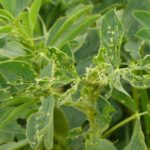First-cut forage yield expectations are quite variable, with some drier areas and winter damaged, older, and fall harvested stands showing reduced yield potential. There is some concern about rebuilding forage inventories to adequate levels. Many new seedings were planted with cereal and cereal-pea mixtures to supply summer forage. (Forage Production From Spring Cereals and Cereal-Pea Mixtures http://www.omafra.gov.on.ca/english/crops/facts/98-041.htm) Demand for sorghum and sorghum-sudan seed is up. (Forage Sorghum-Sudan Grass http://www.omafra.gov.on.ca/english/crops/facts/98-043.htm) Many are planning to follow winter wheat harvest with summer seeded annuals.
Harvest of dairy haylage is likely to be in full swing by the week of May 27th in southern Ontario. Dairy producers generally target harvesting first-cut alfalfa haylage at an optimum 40% NDF. “Scissors-cut” field sampling and rapid laboratory analysis can help predict optimal harvest dates. “PEAQ sticks” and GDD estimates of NDF are also useful. If practical, delaying harvest of stressed fields will improve plant health and increase yield. In mixed stands, be sure to watch the maturity of the grasses when making cutting decisions. (Using Scissors Cutting To Optimize Forage Quality https://fieldcropnews.com/?p=2610)
Alfalfa weevil larvae are being reported in increasing numbers in the south-west. Some are above threshold levels with spraying being done. Feeding damage starts as leaf pinholes, progresses to feeding between the leaf veins and results in a skeletonized appearance. Larvae are bright green with a distinctive white stripe down the centre of the back. Scout to determine if they are above economic threshold levels. Insecticide is recommended only when cutting is impractical, such as when the alfalfa is more than 10 days before harvest maturity. (Alfalfa Weevil https://fieldcropnews.com/?p=3108)
